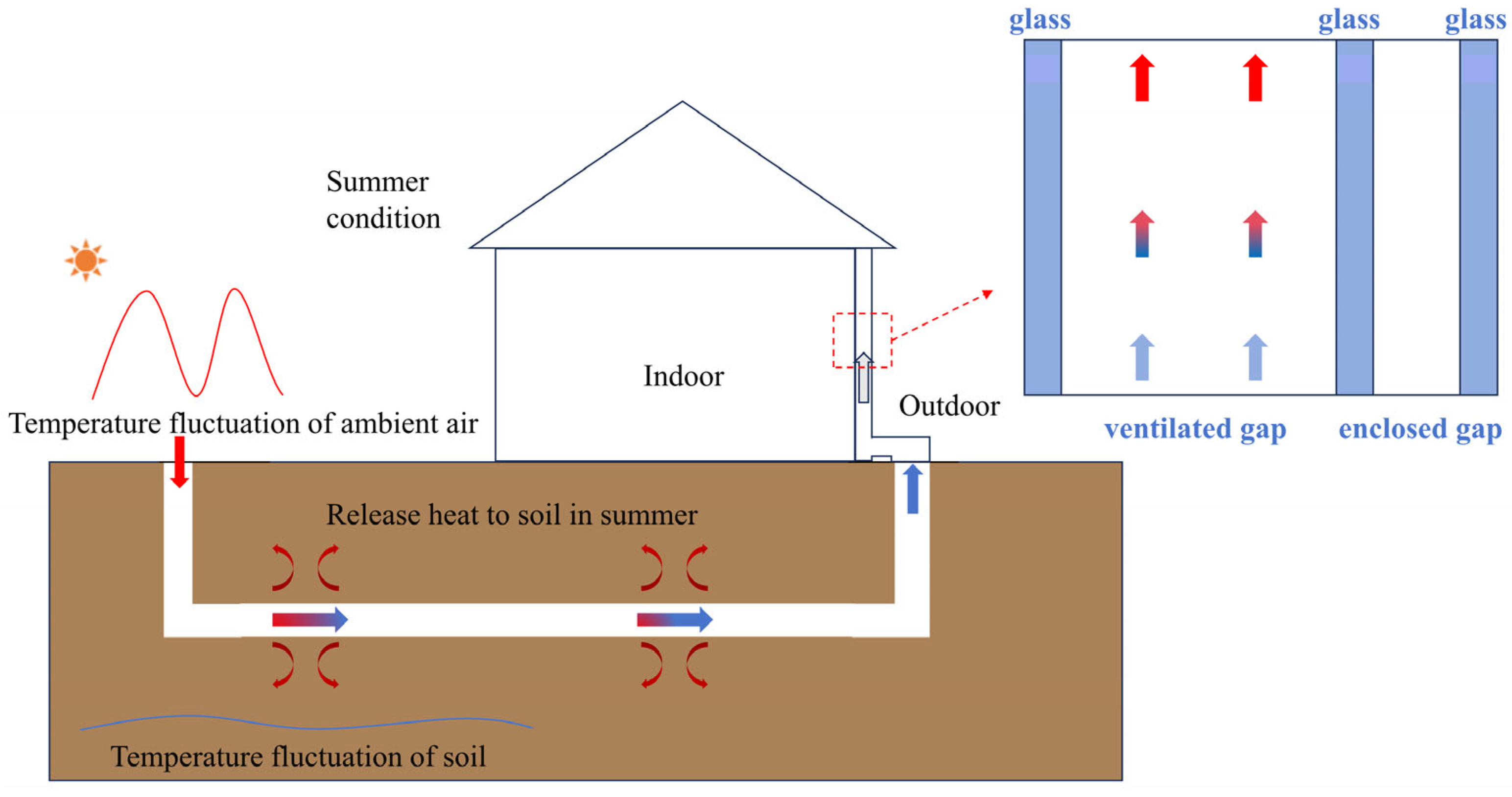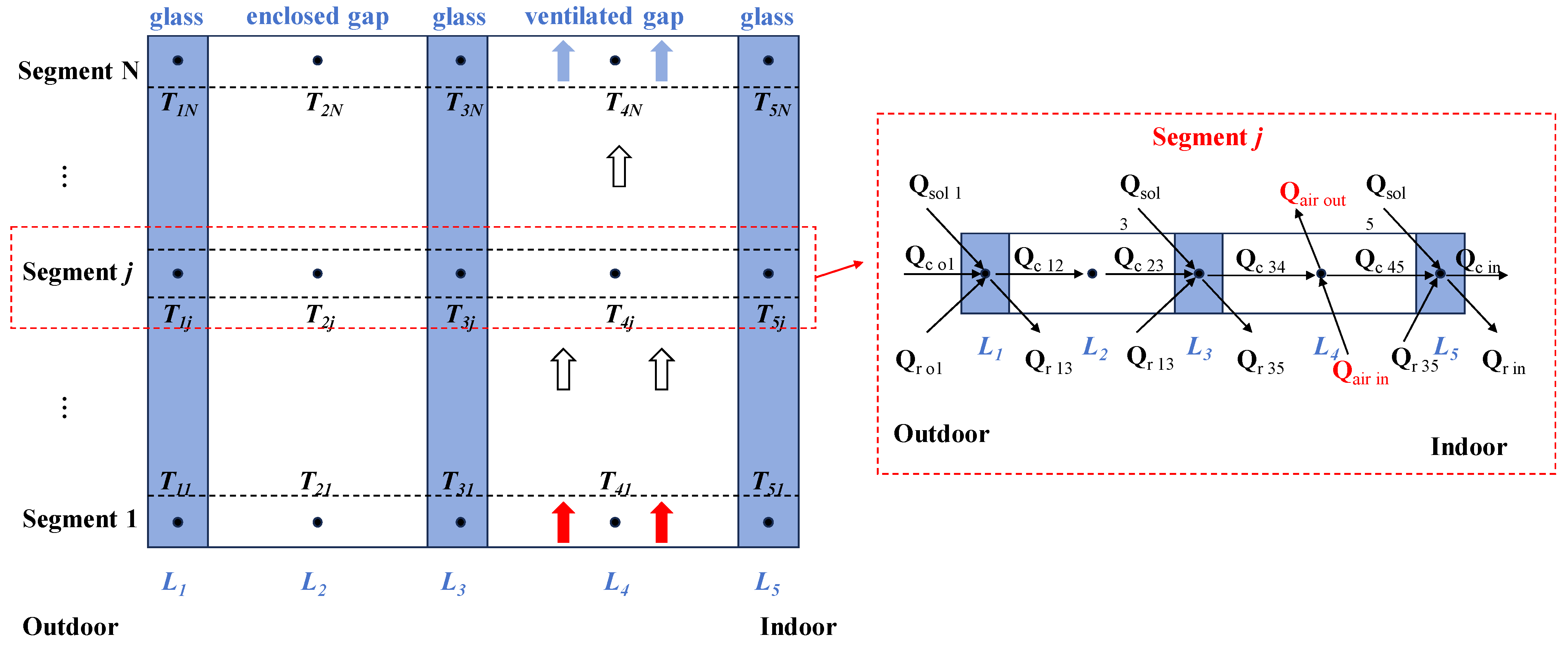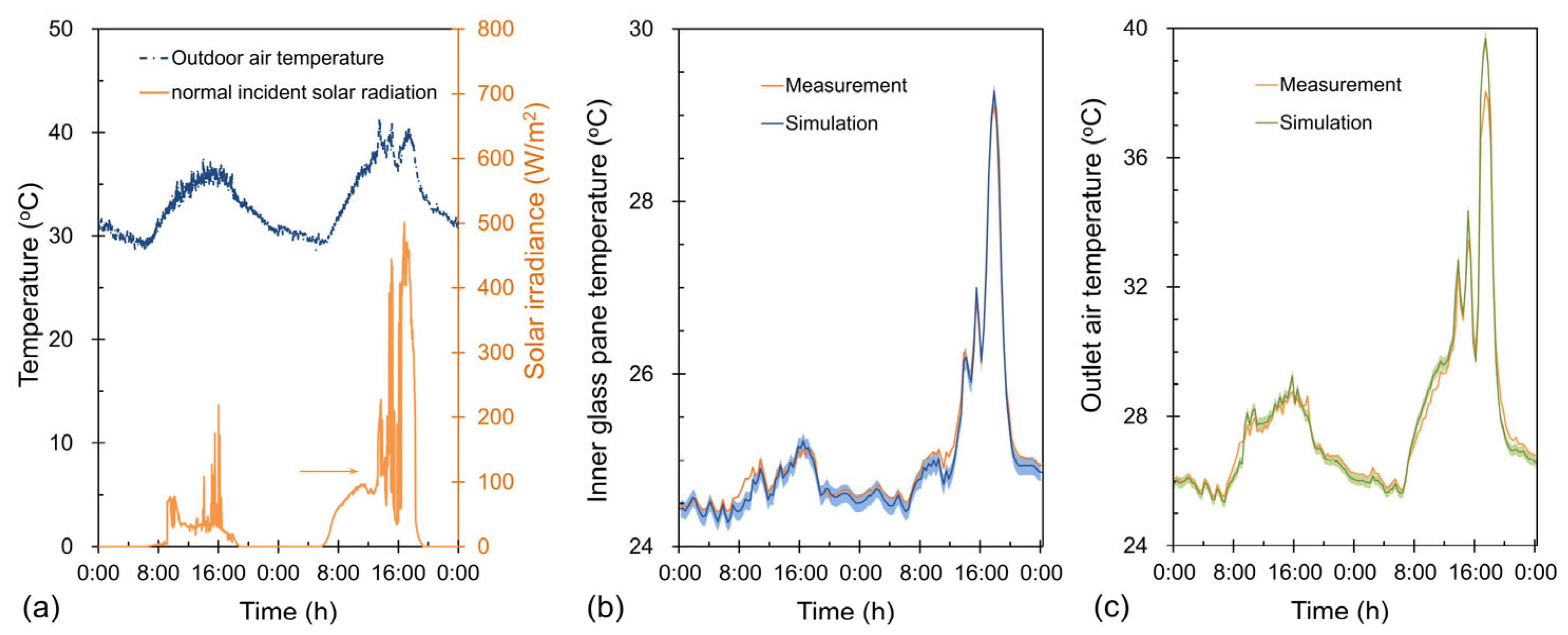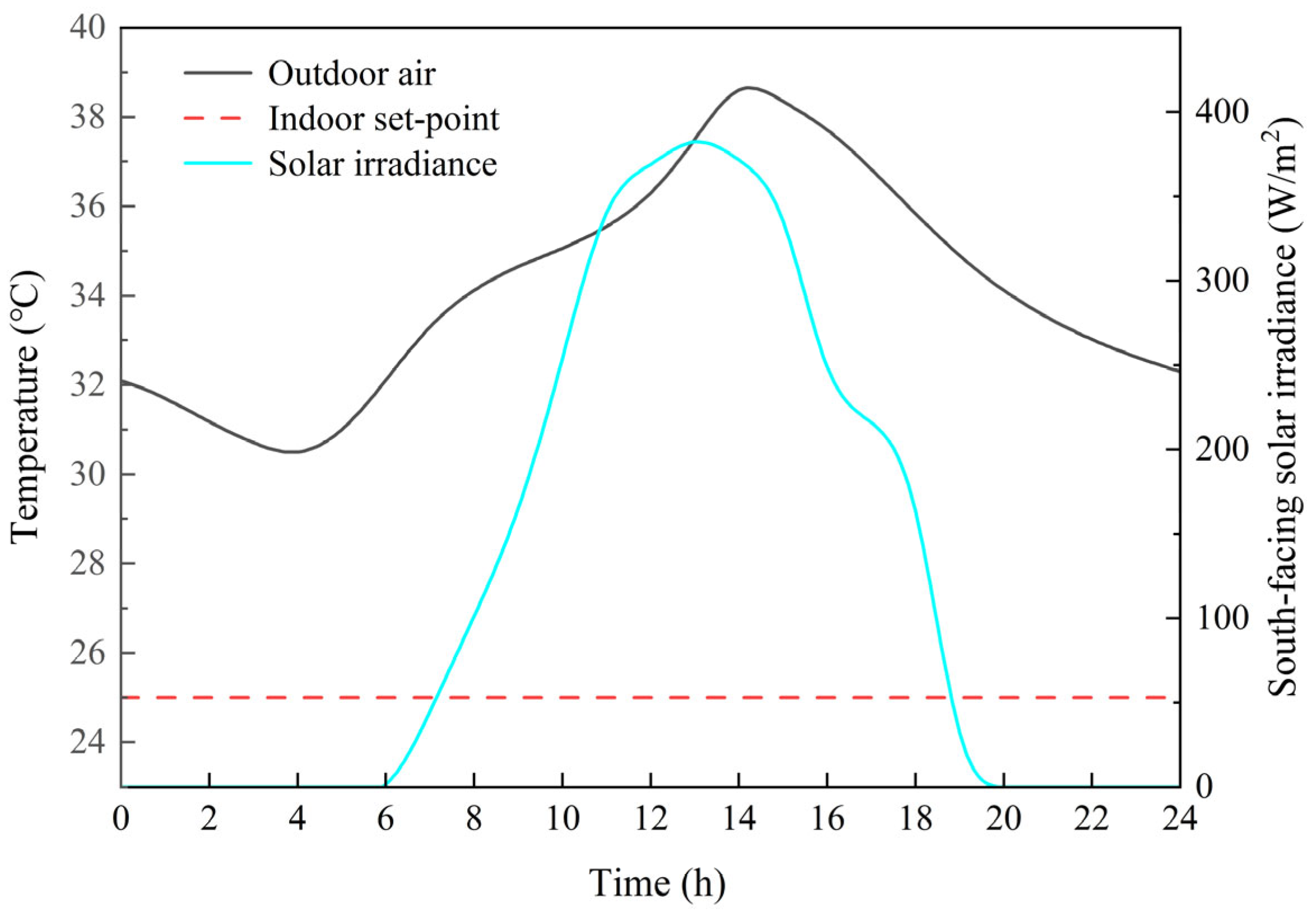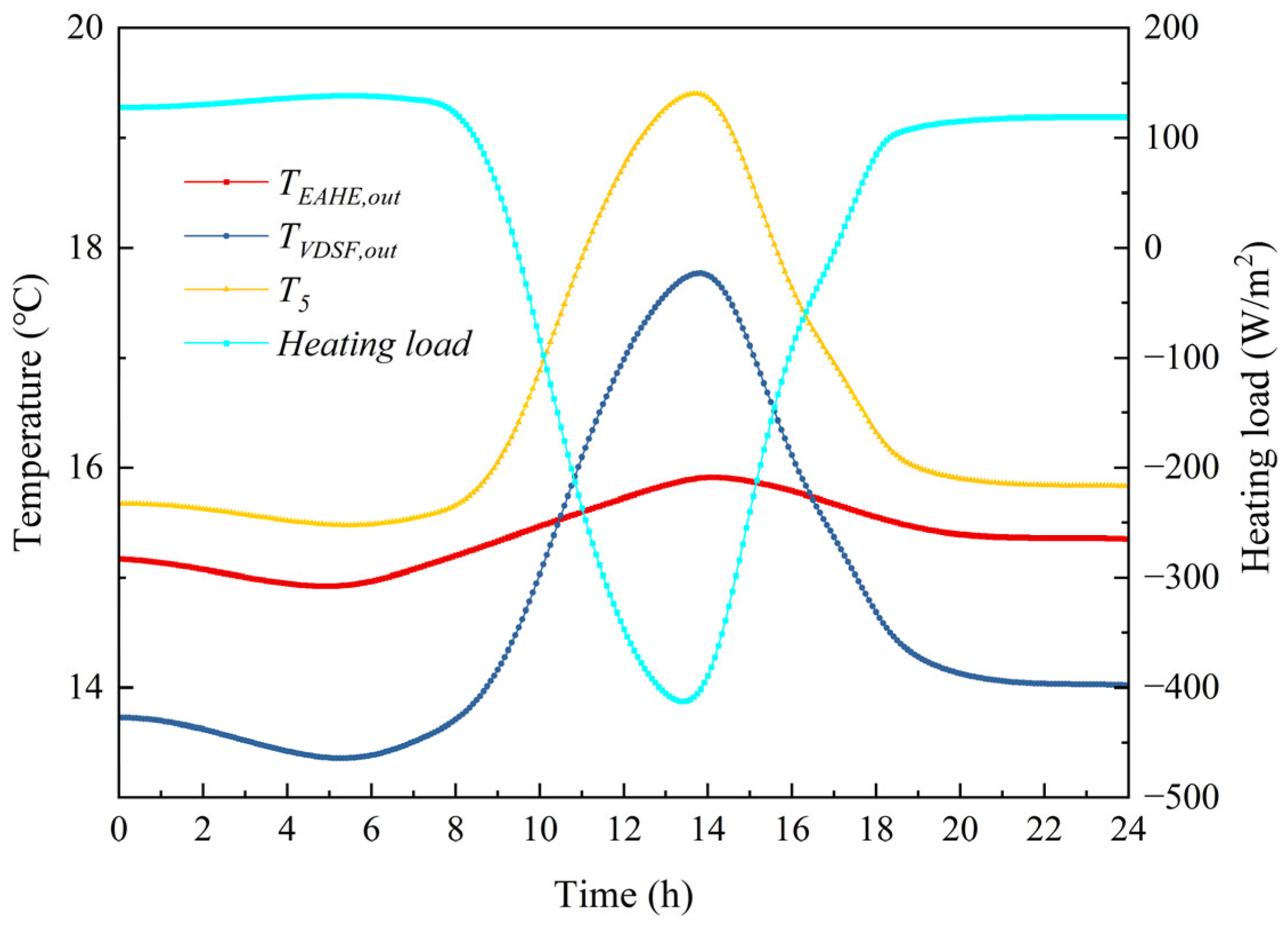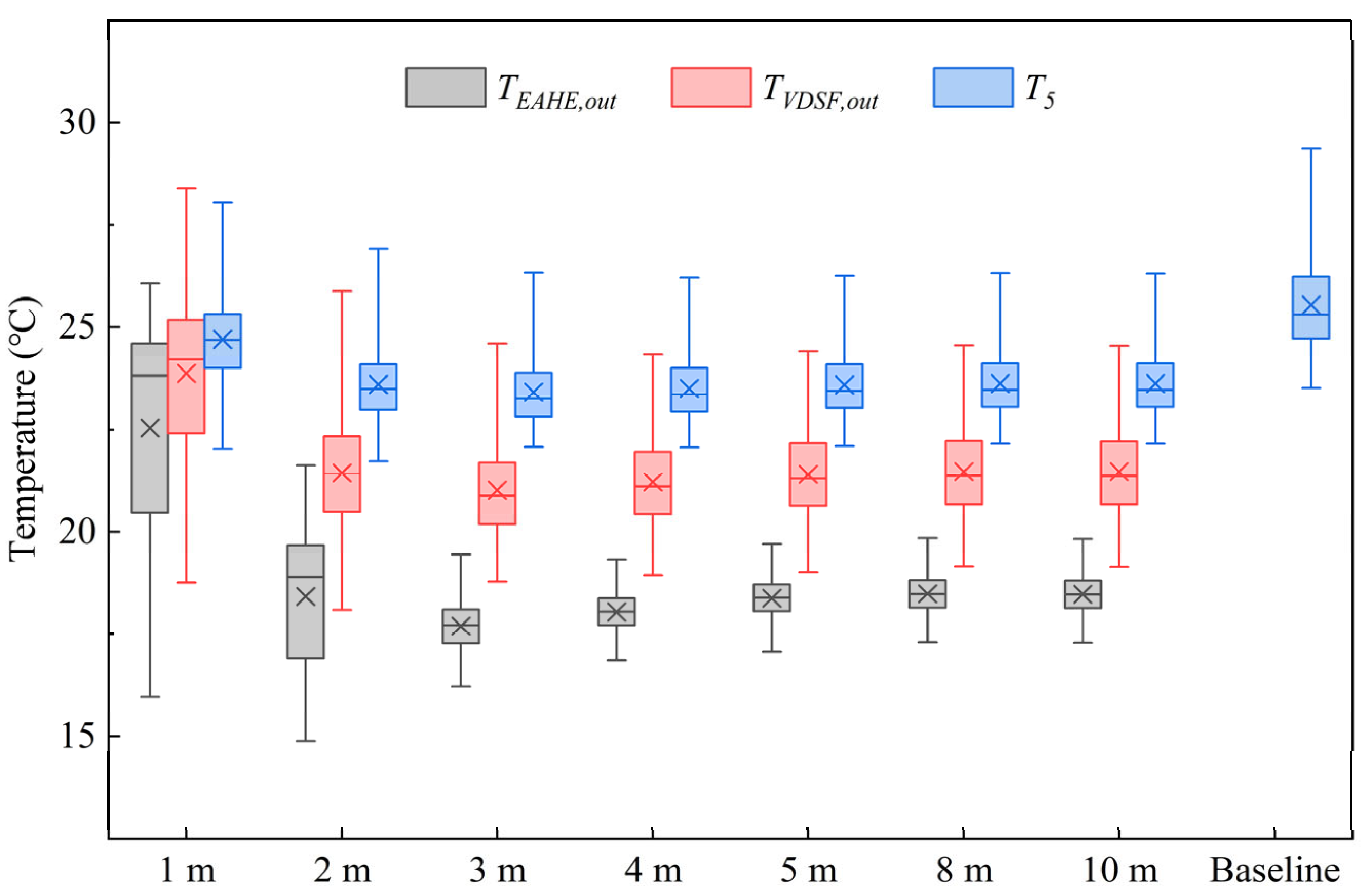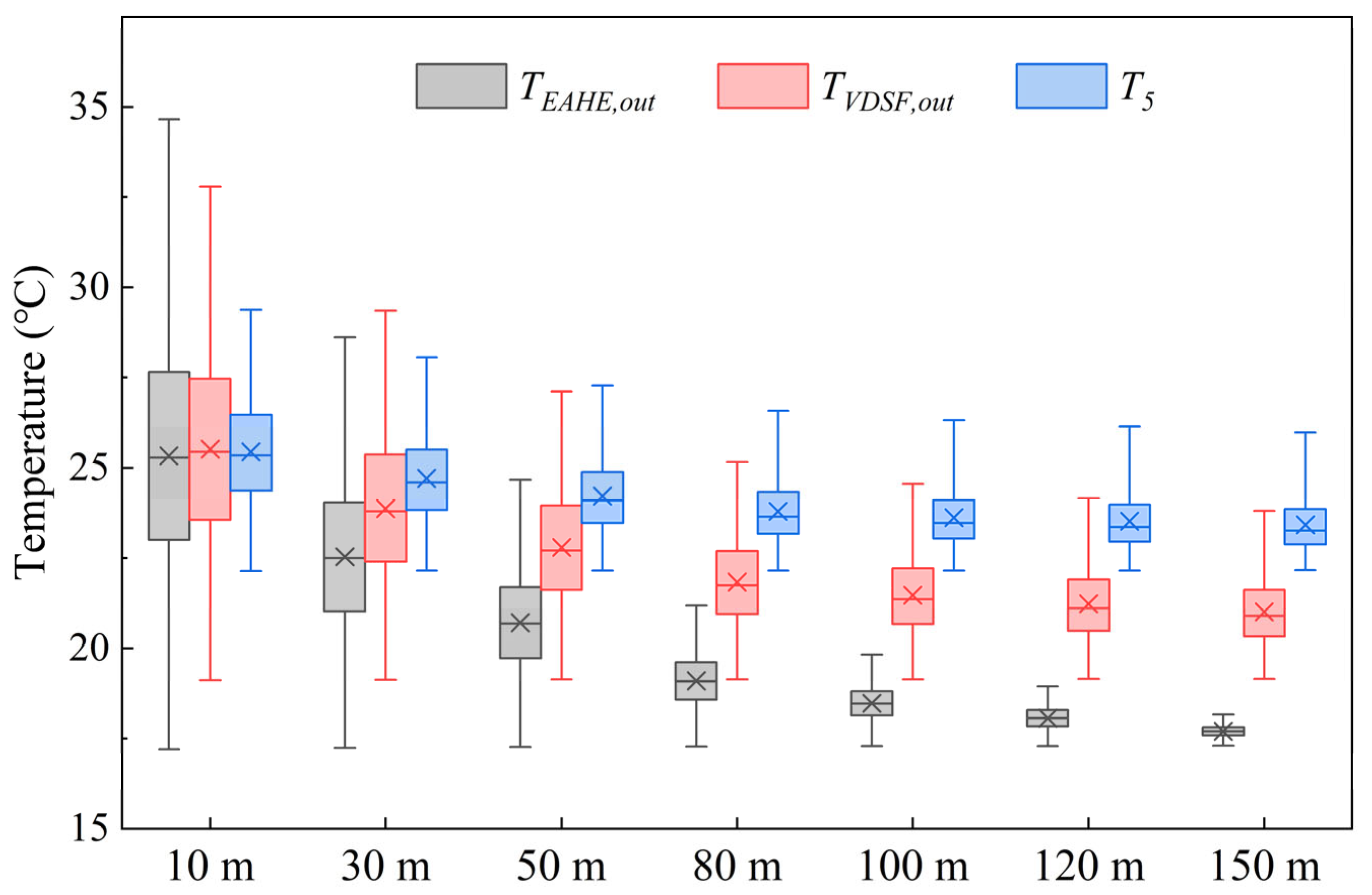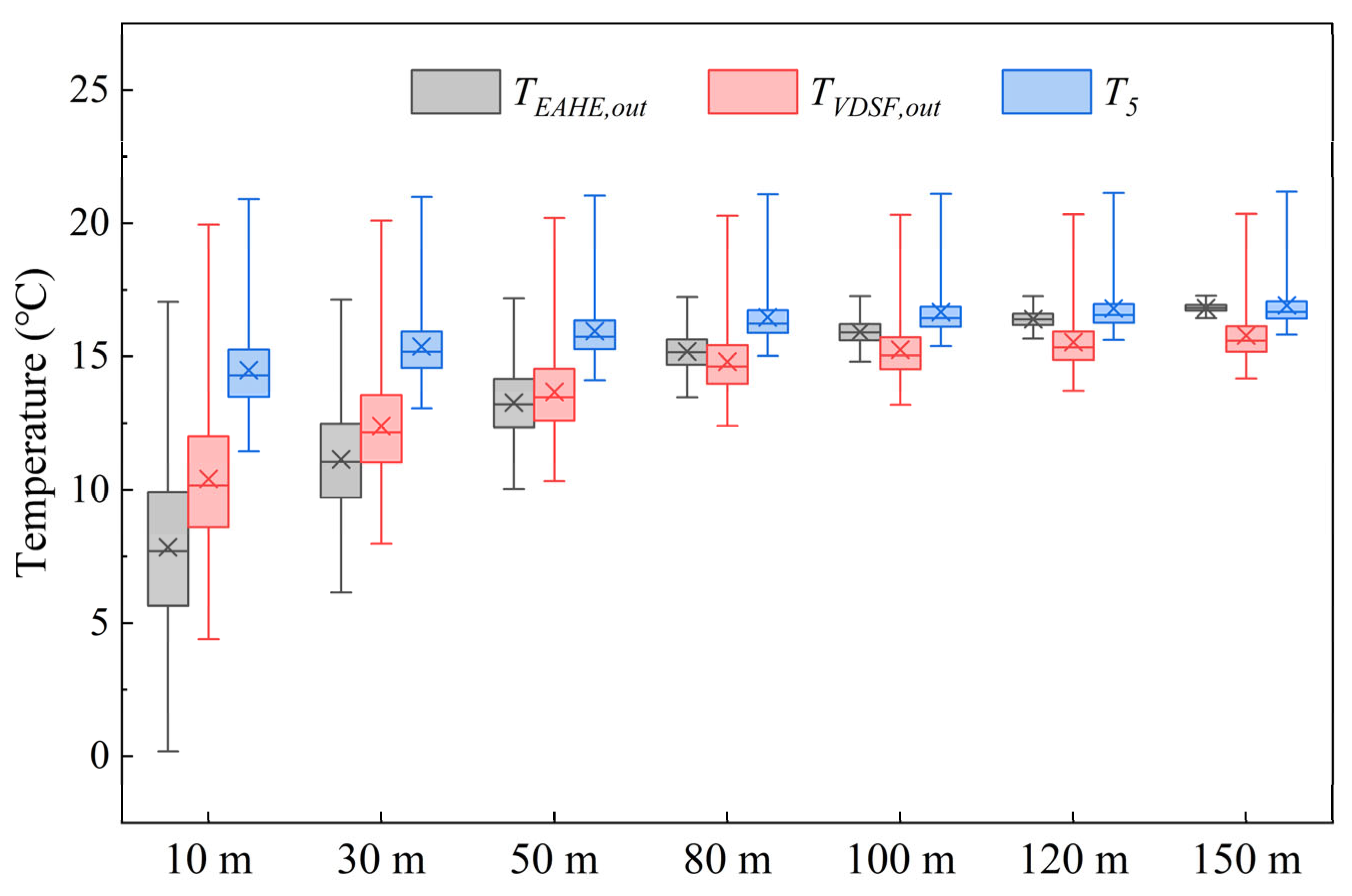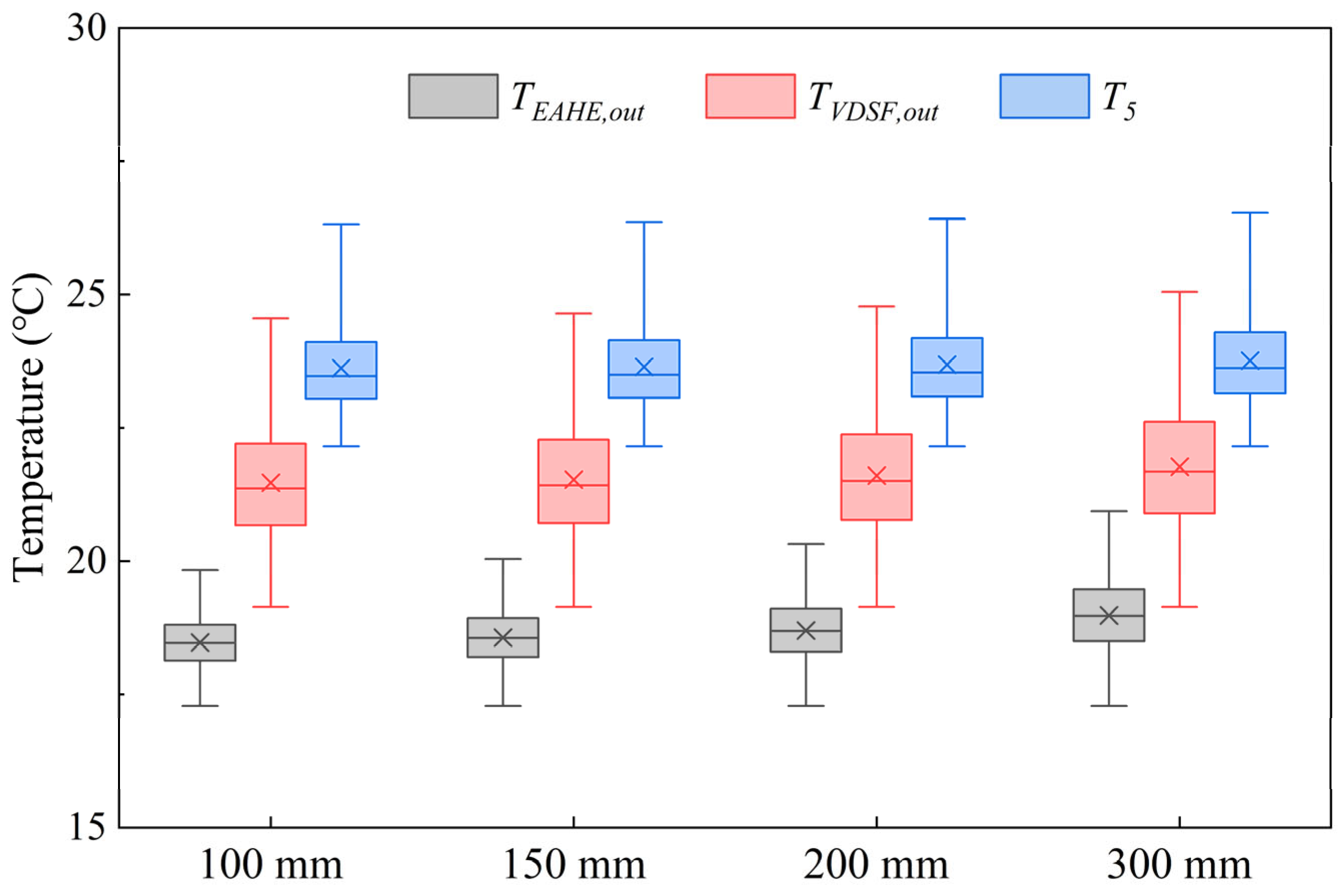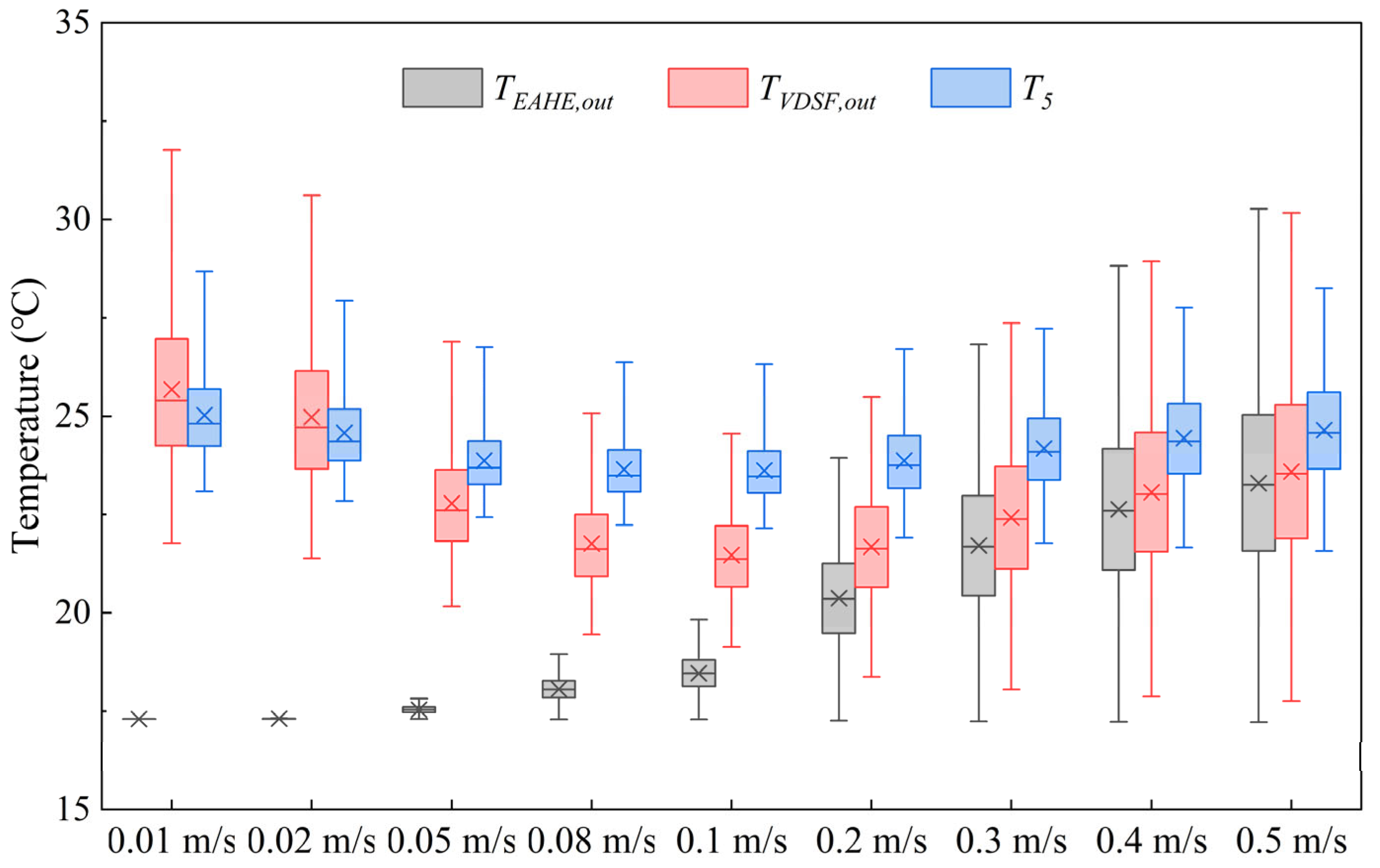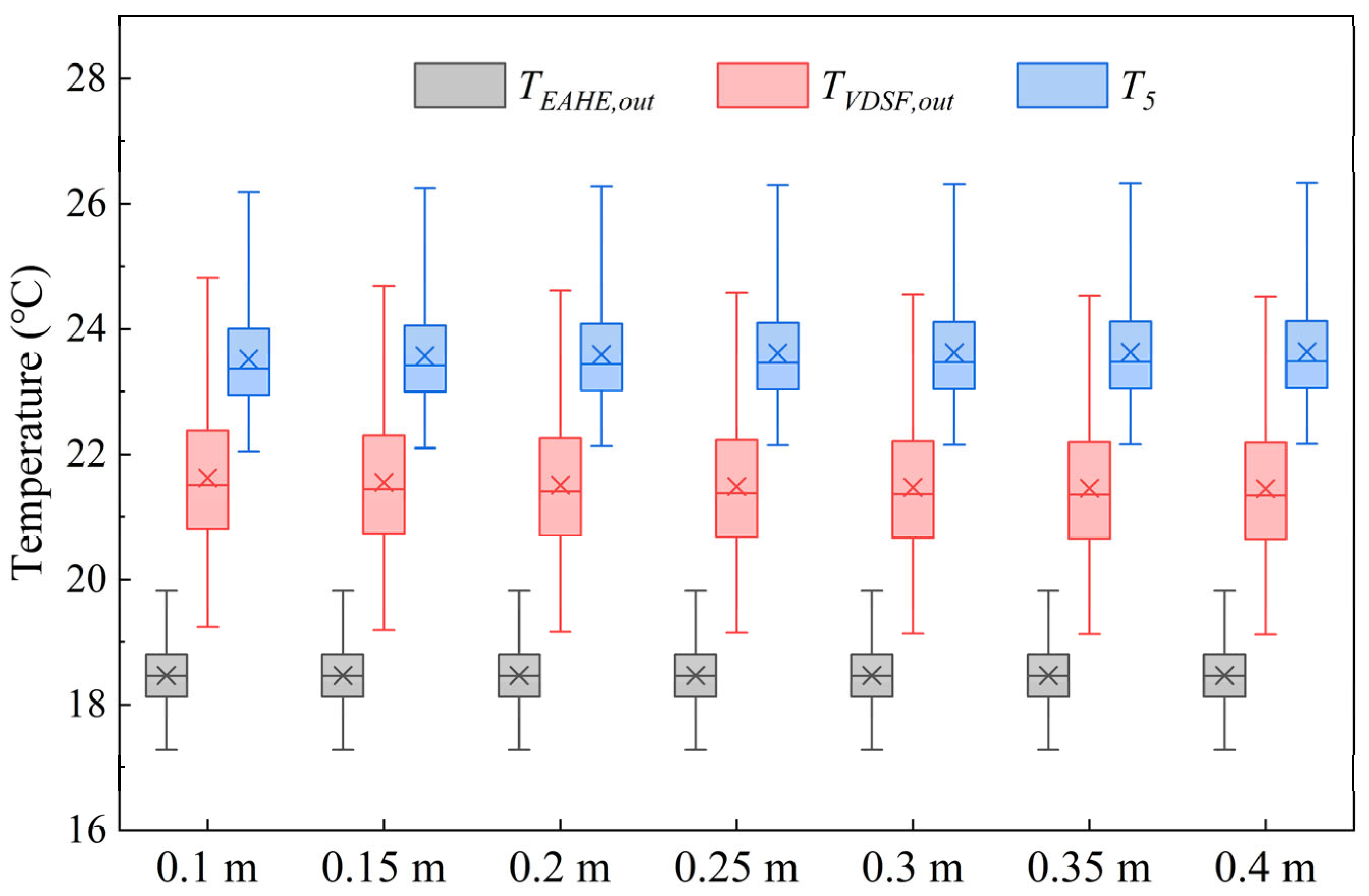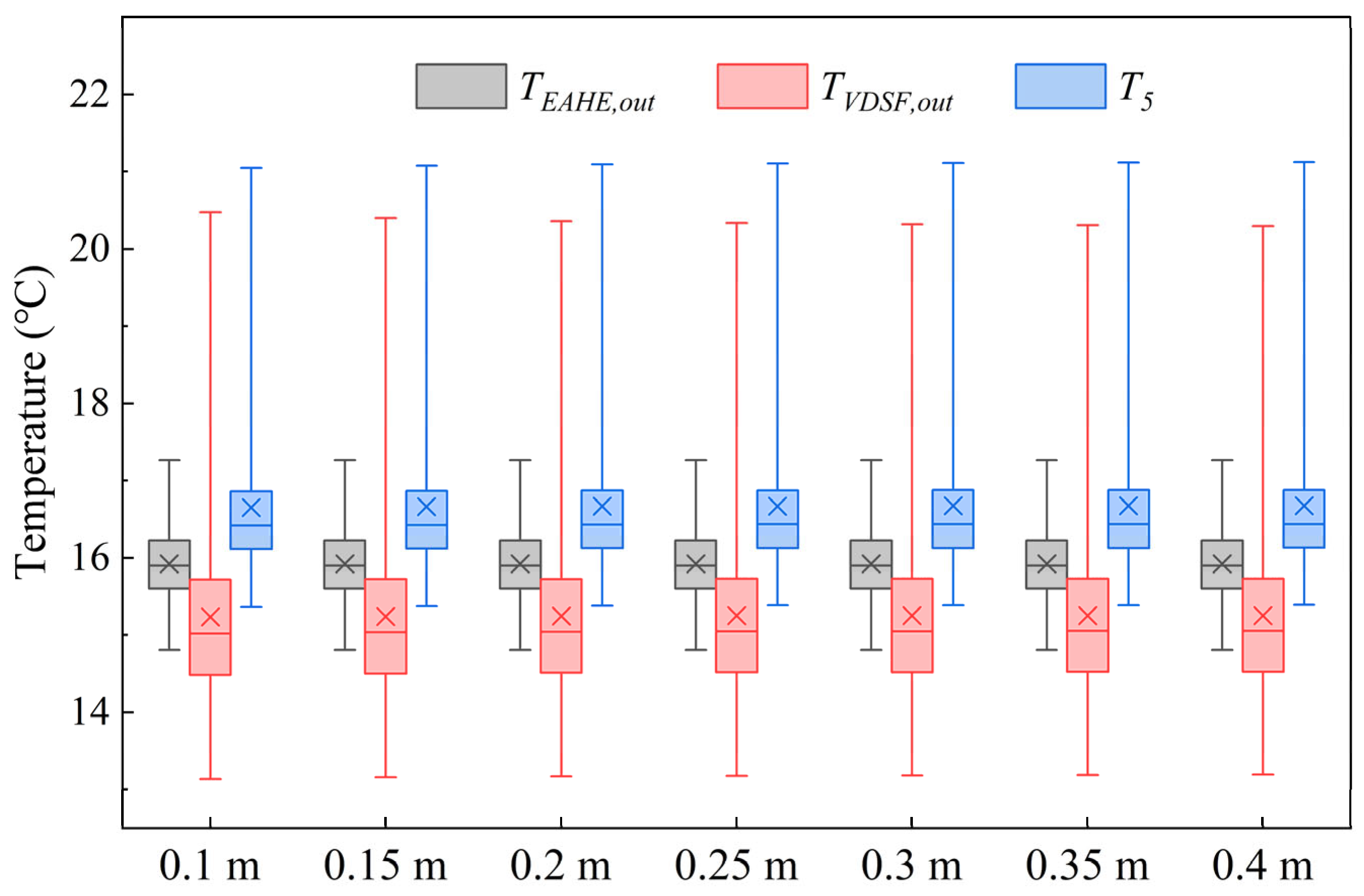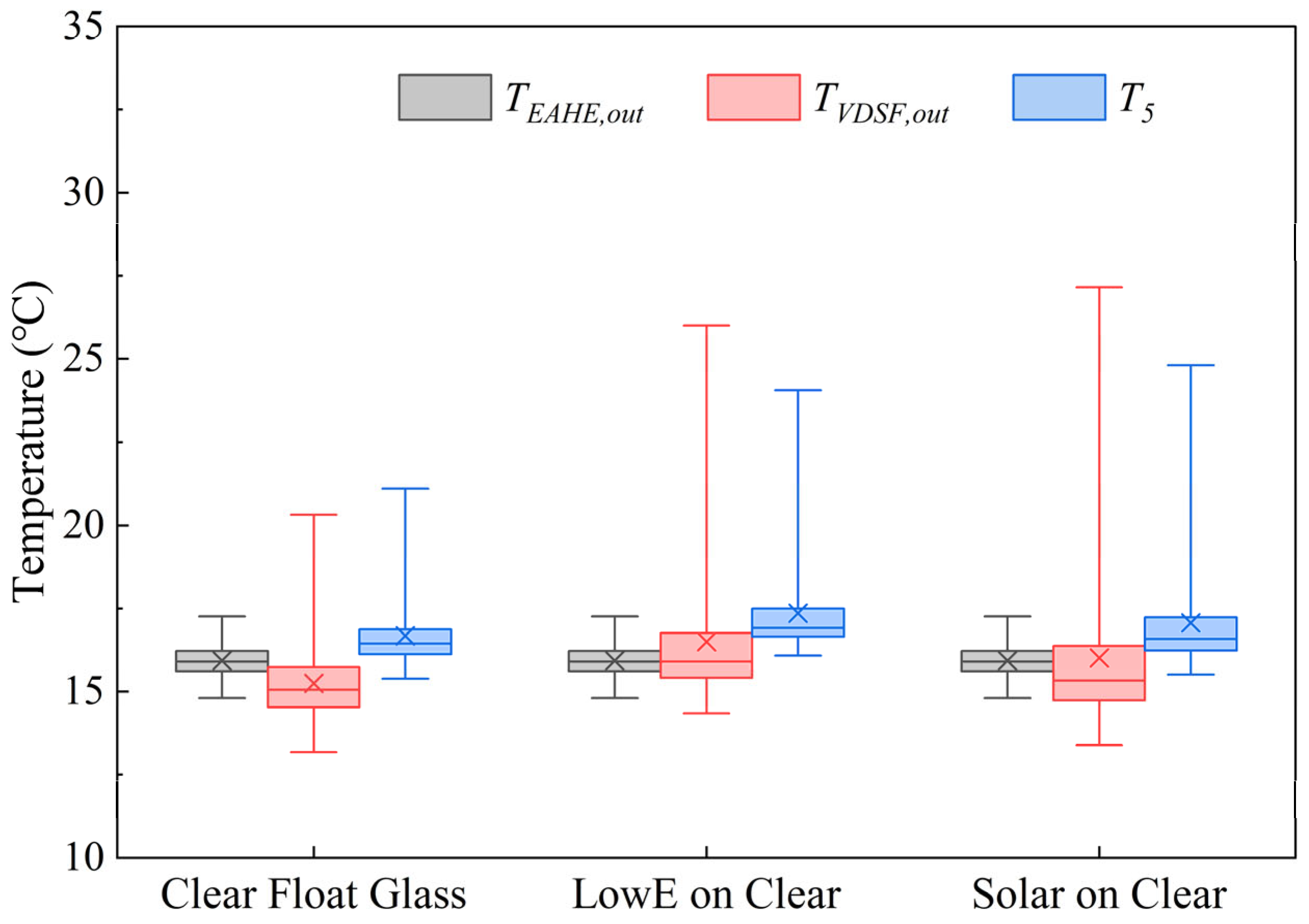1. Introduction
Transparent building envelopes are an important part of buildings [
1], such as windows, glass curtain walls, and glass roofs, which can provide the advantages of unobstructed views, daylighting, and passive solar gain [
2,
3]. It is estimated that building energy consumption accounts for 55% of global energy use [
4], and a large portion of this energy consumption is associated with building envelopes [
5]. However, according to statistics, 30–50% of the heat gain through building envelopes is caused by transparent building envelopes [
6]. Although transparent building envelopes offer aesthetic appeal and daylight access, they have U-values which are approximately three to five times higher (1.5 to 3.0 W/m
2·K) than opaque walls (0.3 to 0.8 W/m
2·K) [
7,
8], which results in disproportionate energy loss. The percentage of solar heat received via transparent building envelopes in peak cooling load is relatively high, especially in cooling-dominated climate regions. Increasing window-to-wall ratios in current architectural designs will also result in a 5–8% [
9] increase in annual cooling energy for every 10% increase in window-to-wall ratios.
So far, some high-performance transparent building envelopes have been developed to improve thermal insulation, solar regulation, energy harvesting, and sustainability. In recent years, relative research on advanced transparent building envelopes has focused on the following aspects. For instance, the integration of phase change materials (PCMs) with transparent building envelopes has been widely explored. Studies have demonstrated that PCMs can reduce building cooling loads by approximately 20% by leveraging latent heat storage to dampen heat transfer fluctuations [
10,
11]. Furthermore, research by Cekon et al. [
12] and Grynning et al. [
13] highlighted the significant role of PCMs in enhancing indoor thermal comfort by modulating temperature swings. Advancements in this area include the development of adaptive PCM-glazing units [
14] and investigations into their dynamic thermal performance at full scale [
15]. Additionally, various solar film coatings are applied to transparent building envelopes, which can lower the U-value while selectively modulating optical properties including emissivity, absorptivity, and reflectivity based on occupancy requirements, thereby limiting indoor solar heat gain and reducing cooling load [
16,
17,
18,
19]. Moreover, glass panels coupled with photovoltaic (PV) laminates can be used to compose building-integrated photovoltaics (BIPVs). This approach not only enhances thermal performance by reducing the U-value of glazing systems but also harnesses solar energy for on-site power generation, thereby improving overall building energy efficiency [
20,
21,
22]. Furthermore, ventilated double-skin facades (DSFs) employs specific operational strategies that vary by season. During the summer, the ventilation airflow driven by the stack effect can release the absorbed solar heat in ventilated DSFs and decrease indoor heat gain, while in the winter, the sealed cavity configuration improves thermal resistance by establishing an enclosed air layer. This dual-mode operation achieves effective heat dissipation in cooling seasons and enhanced thermal insulation in heating conditions [
23].
Current research on DSF primarily focuses on dynamic shading systems, hybrid ventilation strategies, and integrations with photovoltaic (PV) panels. A recent study, which employed two-dimensional computational fluid dynamics (CFD) modeling of DSF with integrated shading devices, demonstrated significant potential for reducing building energy consumption while enhancing thermal comfort [
24]. A further study has shown that incorporating dynamic shading with light shelves substantially improves indoor daylight quality and illuminance distribution uniformity [
25]. Moreover, PV modules are adopted as in-between louvers of ventilated DSF for mitigating solar heat gain and generating electricity on-site [
26]. Naturally ventilated airflow can cool the surface of PV modules by natural convection, which is able to enhance the power generation efficiency of PV modules [
27]. This integrated system not only generates on-site electricity but also significantly mitigates heat gain and heat loss through the building envelope. Despite these advancements, cavity overheating in DSF remains a persistent challenge during summer operation in cooling-dominated climates [
28,
29,
30,
31].
The development of such integrated passive solutions is critical for enhancing building resilience under future climate scenarios [
32]. The effectiveness of passive techniques, however, is highly dependent on their synergistic design and local climatic conditions [
33]. Based on this rationale, this study leverages low-grade shallow geothermal energy to mitigate cavity overheating in DSF. To mitigate overheating in double-skin facades (DSF), low-grade natural energy sources can be utilized. Pipe-embedded DSFs have been proposed, where circulating water within pipes integrated into shading layers directly releases absorbed solar heat. This system employs naturally cooled water sources to resolve cavity overheating issues in conventional DSF configurations [
34,
35,
36,
37]. A pipe-embedded DSF significantly reduced cavity temperatures, decreasing louver mean temperatures from approximately 57 °C to 25.4 °C and lowering overall cavity temperatures to roughly 29 °C, which was substantially below ambient air conditions [
34,
35]. Furthermore, the solar heat gain coefficient (SHGC) of the pipe-embedded DSF was reduced to 60% of that of conventional DSF values, which was attributed to the decreased solar heat gain through the pipe-embedded shading layer [
37].
A water flow window (WFW) permits the circulation of low-grade water through the space between two glass panels [
38]. During the cooling season, low-grade waterflow can be generated through evaporative cooling, ground heat exchangers, etc. Compared to conventional windows, WFW systems circulate cool water within the cavity to efficiently lower inner glazing surface temperatures and diminish heat transmission through fenestration [
39]. This configuration achieves enhanced solar shading and cooling load reduction. During the heating season, warm water circulation generated by the solar heat collector can effectively reduce indoor heat loss through windows [
40]. Moreover, WFW systems regulate the temperatures of inner glazing surfaces, substantially narrowing the temperature fluctuation and improving indoor thermal comfort [
39].
The above-mentioned studies demonstrated that a cool airflow or waterflow generated by low-grade energy sources can be utilized to avoid overheating in DSF and reduce the cooling load in the summer. The earth-to-air heat exchanger (EAHE) is designed to exchange heat between the soil and air that flows through a buried pipe [
41]. At a specific depth, the subterranean soil temperature remains relatively constant throughout the year, with only minor fluctuations. In the winter, the temperature of the soil underground is much higher than the temperature of the ambient air, and in the summer, it is much lower. The EAHE preheats intake air in the winter and precools it in the summer, utilizing shallow geothermal energy for space heating/cooling [
42,
43]. It is estimated that EAHE maintains stable outlet air temperatures after certain pipe lengths, generally around 30 m.
This study proposes a novel earth-to-air heat exchanger-assisted ventilated double-skin facade (EAHE-VDSF), which utilizes shallow geothermal energy to continuously provide cool/warm airflow for minimizing the heat gain/loss through DSF in the summer or winter. This integrated system offers an alternative method for utilizing low-grade shallow geothermal to achieve thermal regulation of DSF and energy saving in buildings. Compared with above-mentioned water-based thermal regulation DSF (e.g., pipe-embedded windows or water-flow glazing), the EAHE-VDSF eliminates the need for installing additional heating and cooling equipment and avoids freeze and corrosion risks. For the practical application of EAHE-VDSF, the thermal performance of this system should be quantitatively estimated in both cooling and heating seasons. It is essential to ascertain the influence of critical design factors on thermal performance of EAHE-VDSF and determine the recommended design parameter.
The main objectives of this paper are to (a) develop an integrated EAHE-VDSF system that utilize low-grade shallow geothermal energy to achieve thermal regulation of DSF, (b) establish a coupled simulation model to analyze the thermal performance of the EAHE-VDSF, (c) identify the influence of critical design factors on thermal performance and determine the optimal design parameter. The paper is structured as follows:
Section 2 details system configuration, heat transfer processes, and numerical model development with validation.
Section 3 presents the case study methodology. Results and comparative analysis are discussed in
Section 4, followed by discussion in
Section 5. Finally, Conclusions are presented in
Section 6.
3. Boundary Conditions of Case Study
This study employs a representative case study under a typical hot-summer-and-cold-winter climate condition to evaluate the thermal performance of the EAHE-VDSF coupled system. The typical meteorological year data of Wuhan city (typical hot-summer-and-cold-winter climate zone) was used for the simulation. Typical meteorological year data is a commonly used type of data for building energy simulation as it represents long-term climatic patterns. The system is installed within a reference office room (4 m × 4 m × 3 m) and consists of an EAHE subsystem and a south-oriented VDSF. The basic EAHE system features a buried pipe at a depth of 10 m, with a length of 100 m and an internal diameter of 0.1 m. The VDSF has dimensions of 4 m in width and 3 m in height, featuring three glazing panes, each with a thickness of 6 mm, a sealed cavity measuring 9 mm, and a ventilated cavity that is 30 mm thick. The key design parameters of the EAHE system used in this study are provided in
Table 4.
Figure 5 and
Figure 6 present the outdoor weather parameters of the typical summer and winter design day in Wuhan, respectively. The setpoint of indoor temperature was maintained at 25 °C and 18 °C throughout the cooling and heating season, respectively.
The thermal performance of the coupled EAHE-VDSF system was evaluated for typical summer and winter design days. Primary performance metrics including the outlet air temperature of the EAHE, the inner surface temperature of the VDSF glazing, the VDSF exhaust air outlet temperature, and the cooling/heating load of the VDSF were comprehensively investigated. The hourly cooling and heating load of the window can be calculated by Equations (14) and (15).
where
Qcool and
Qheat are the hourly cooling and heating load of the VDSF, W/m
2;
T5 is the internal surface temperature of the room-side glazing (K).
τ represents the total solar transmittance of the entire VDSF system. The value of
τ for the baseline case (clear float glass) was calculated to be 0.5761 using WINDOW 8.0 software, as detailed in
Section 4.3.3.
To quantify the absolute energy-saving potential of the proposed EAHE-VDSF system, a conventional triple-glazed, non-ventilated facade with identical dimensions and glazing properties was adopted as the baseline case. All the performance metrics (e.g., temperatures and energy loads) of the conventional triple-glazed, non-ventilated facade were compared with that of the proposed EAHE-VDSF system. Furthermore, a comprehensive parametric analysis was conducted to assess the influence of key design parameters on system performance. This study analyzes the design parameters of EAHE, focusing on buried pipe depth, length, and diameter, as well as the design parameters of VDSF, which include airflow rate in the ventilated cavity, cavity size, and glazing optical properties such as solar transmittance and absorptivity.
5. Discussion
5.1. Assumptions and Uncertainties of Numerical Modeling
The model is built upon several assumptions commonly adopted in related research to balance computational cost and accuracy: The 2D simplification for the VDSF neglects heat transfer along the horizontal direction, which is justified given the dominant vertical temperature stratification in tall facades [
47,
48]. The soil surrounding the EAHE is assumed to be homogeneous and isotropic, a standard assumption for preliminary design and analysis [
41,
44]. Thermal energy storage of air within the cavities is neglected. In this study, the uncertainties of simulation results may be derived from parameter uncertainty (e.g., soil thermal properties), input uncertainty (e.g., TMY weather data), and model-structure uncertainty (e.g., the 2D simplification).
A comprehensive sensitivity analysis of the key design parameters has, in fact, been presented in
Section 4.2 and
Section 4.3. The parametric studies on pipe depth, length, diameter, and airflow rate effectively serve as a detailed sensitivity check, quantifying the impact of these key inputs on the system’s thermal performance (e.g., cooling load varied from 57.0 to 217.6 kWh/m
2 with pipe length). The results indicate that the system output is most sensitive to pipe length and ventilated airflow rate, while being less sensitive to pipe diameter and cavity thickness.
The findings are most reliable for buildings in climates similar to hot-summer–cold-winter zones. The identified strong sensitivity to pipe length and airflow rate provides clear guidance for practitioners: these parameters should be prioritized in design optimization. The relatively low sensitivity to pipe diameter suggests that cost and practical installation constraints can guide pipe diameter selection without significantly compromising performance. Engineers should be aware that soil property variability is a key source of uncertainty and site-specific geotechnical surveys are recommended for detailed design.
5.2. Performance of This Coupled System
The EAHE coupled with the VDSF creates an effective solution for low-grade geothermal energy utilization in transparent building envelopes. The above results indicate that the preconditioning of ambient air through the EAHE can effectively reduce overheating issues inherent to summer associated with conventional VDSFs and significantly reduce the cooling and heating load of VDSFs throughout the whole year. During the cooling season, the EAHE lowers ambient air temperature by an average of 15 °C, with a maximum reduction from 38.7 °C to 19.8 °C, utilizing the high thermal inertia of shallow soil layers, which are approximately 18 °C at a depth of 10 m. The average interior glazing surface temperature of the VDSF is 24.8 °C and very close to the indoor temperature. This results in a 48% reduction in annual cooling load at optimal burial depth. In the heating season, the EAHE preheats the flowing ambient air within a buried pipe and raises its temperature by 14.3 °C, facilitating net heat gain through the facade during the daytime and reducing the heating load of the VDSF by 50.9%. Based on the above discussion, it can be concluded that the coupled EAHE-VDSF system can provide an alternative approach to effectively precool/preheat ventilation air and achieve promising energy-saving potential for building ventilation in hot-summer-and-cold-winter climates.
5.3. Recommended Design Parameters
In this study, the influence of critical design factors on thermal performance of EAHE-VDSF systems was systemically investigated. Regarding the depth of the horizontal buried pipe in EAHEs, the underground soil temperature at different depths exhibits high thermal variability due to the impact of the ambient environment. As the depth of the buried pipe exceeds 4 m, stability and consistency in the precooling and preheating capacities of an EAHE can be achieved. Although deeper burial (>8 m) further stabilizes outputs, diminishing returns are evident, characterized by minimal variation (less than 0.5 °C) of outlet air temperature. Thus, 4 m to 5 m represents a cost-effective optimum for cooling/heating load reductions exceeding 48%. The recommended length for buried pipes in EAHEs is between 80 m and 100 m, as extending the pipe length beyond 100 m yields only marginal improvements in the thermal performance of the coupled system. Increasing the diameter of the buried pipe slightly decreases the cooling and heating load of EAHE-VDSF coupled systems and its impact is very limited. Concerning the ventilated airflow rate in the VDSF, there exists an optimal ventilated airflow rate that achieves the minimum cooling and heating loads of VDSFs in the summer and winter, respectively. This optimal value of the ventilated airflow rate may be influenced by local climate conditions and various design parameters of the EAHE-VDSF coupled system, highlighting the necessity for variable-speed fan control in practical applications of this system. Regarding glazing selection, further employing low-E glazing in VDSFs is recommended, which can further reduce the cooling and heating loads by 28.1% and 34.1% compared to the use of clear glass.
5.4. Practical Implications, Limitations, and Future Research
This study shows the EAHE-VDSF system’s considerable thermal performance and energy-saving potential, but in order to appropriately assess its feasibility and generalizability, several crucial practical issues and implications for future studies need to be discussed.
Firstly, this study is subject to limitations inherent to its simulation-based approach. Although the EAHE and VDSF sub-models were individually validated with satisfactory accuracy, the fully coupled EAHE-VDSF system has not been tested against integrated experimental data. The potential for interactive effects or error accumulation between the subsystems thus remains unquantified. Furthermore, the analysis relies on typical meteorological year (TMY) data. As highlighted in prior research [
55,
56], such data may not capture urban microclimatic effects like the urban heat island (UHI) effect, potentially leading to an underestimation of cooling loads in real urban settings. Consequently, the present findings are most directly applicable for comparative analysis and concept validation.
Secondly, although the main focus of this work was energy load reduction, the system’s impact on indoor environmental quality is crucial. The stabilization of the interior glazing surface temperature (T5) significantly contributes to improved thermal comfort by reducing radiant temperature asymmetry. Future experimental studies should incorporate detailed comfort assessments, including metrics such as Predicted Mean Vote (PMV) and operative temperature, to quantitatively evaluate the overall comfort benefits. Additionally, the potential for draught and noise generated by the ventilation system should be systematically evaluated in real-world applications.
Thirdly, a comprehensive evaluation of the system’s net energy benefit requires accounting for additional energy consumption. The energy input for the fan or blower to overcome pressure drops in the EAHE pipe and the VDSF cavity was not included in the current energy balance. Preliminary estimates suggest that fan energy consumption would be substantially lower than the achieved heating and cooling savings, indicating a high seasonal Coefficient of Performance (COP). However, a detailed analysis quantifying pressure drops, optimizing fan selection and control strategies, and calculating the net energy saving and seasonal COP will be fully addressed in future research.
Additionally, the long-term practical feasibility of the system involves considerations beyond the scope of this simulation-based study. Issues such as soil pipe fouling, moisture management, and maintenance access for the buried EAHE components are critical for real-world deployment. These challenges can be addressed through engineering solutions, such as using smooth-walled pipes (e.g., HDPE), installing sediment traps, and designing inspection points.
Furthermore, a simplified economic analysis was conducted to preliminarily estimate the payback period of installing an additional EAHE system to the conventional non-ventilated DSF. Economic analysis was conducted using the recommended design parameters of 10 m depth, 100 m length, and 100 mm pipe diameter.
Table 12 lists the initial cost based on the local price of installing an EAHE system. Based on the previously mentioned simulation results, it is estimated that the EAHE-VDSF system will reduce 38.8 kWh/m
2 annual electricity consumption compared with conventional DSFs, assuming an average 4.0 COP for typical heat pump operation. Considering the local electricity price of 0.608 CNY/kWh, the payback periods of installing an additional EAHE system are 2.8 years, 5.5 years, and 13.8 years for integration with a 100 m
2, 50 m
2, and 20 m
2 glass curtain, respectively. This indicates that a larger glazing area shows better economic attractiveness for this EAHE-VDSF coupled system.
Finally, the findings of this study are based on a specific climatic context (Wuhan, hot-summer-and-cold-winter climate). To evaluate the general applicability of the system, future research will encompass annual simulations, investigations into various facade orientations, and performance evaluations across a diverse range of climate zones.
